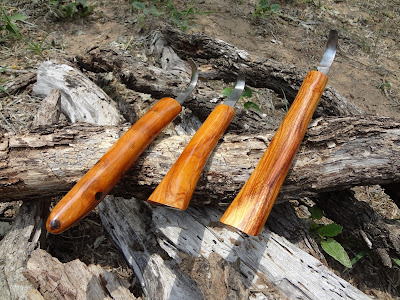Whittling is one of those nebulous terms that can imply a range
of activities from carving figurines and geometric shapes to nothing more
than sharpening a stick. As in a lot of
things the definition rests more with the skills of the doer than with the word
itself. There’s nothing wrong with that
since whittling is meant to be a solitary experience. One sits down with a sharp knife and a piece
of green wood and, assuming proper technique, shaves and cuts and otherwise
whittles. Years ago I saw a man
whittling with a piece of glass and I suspect the first whittler used stone flakes
or sea shells. Venus sunray clams were
used by Indians along the Texas Gulf Coast in pre-Colombian times for scraping
and woodcarving. Nowadays people use
knives. The classic whittling knife is
probably a slipjoint (pocket knife) with from one to three blades. Assuming sufficiently hard steel a slipjoint
makes an excellent whittling tool and I use pocket knives more than any other knife. Even so, I’ve made fixed-blade woodcarving
knives and now and then I’ll toss one into my shoulder bag and find a quiet
spot and then sit down and begin whittling.
It’s as much a moment spent in contemplation as anything else. Mind you, my whittling endeavors do not
amount to anything fancy. I might throw
in a hook knife and make a spoon and, in fact, I could use the “hook” for the
entire process; but being an aficionado of the knife I like carrying more than
one cutting tool. Life should be
eclectic in that sense. And besides, one
should do things incorporating more than a singular mental or motor pathway. If you work on a computer all day, for
example, then perhaps you might crochet at night. But then I don’t crochet so I make knives and
selfbows, spoons and bowls. I also enjoy
playing the guitar.
Please allow me to show you some photographs of a couple of
whittling and woodcarving knives I made a few years ago. They are very sharp and they work very well. In fact, I’ve thought about making some more
of these knives since there is a satisfaction in having made the tool that was later
used to whittle a piece of wood and thus form something else.
The steel is 1095 and the wood is Texas ebony. Softer steels will work but not as well. You can buy a nicely made Chinese slipjoint
pocket knife for less than fifteen-bucks but invariably they are made of 440A
stainless steel. If the wood is green
and soft then 440A works okay. If the
wood is hard then 440 of any sort works poorly.
There are other steels but 1095 is easy to cook and pound and I see no
reason to experiment with anything else.
Blade lengths need not be more than a couple of inches. With the two knives pictured I can make an
impromptu walking cane or fashion a trigger for a snare.
Beauty is something humans enjoy incorporating into their tools
whether a small whittling knife or a 16 gauge double made in the Basque
country. Thus a well-shaped blade and
pretty wood make for an attractive knife.
I have to be in the mood to make a knife. Sometimes I’ll go for weeks and not make
anything. In the interim I’ll spend my
time doing other things. Of course,
there is always woods roaming. The
excitement of the long walk does not fade.
Day before yesterday I surprised a big boar hog while on my walk and
two days before that I took note of the leather-stem (Jatropha dioica) now covered in leaves which is rare. Sometimes I can’t sleep and so I’ll get up and
grab a flashlight and go for a hike.
A while back I spotted two amber eyes looking at me. I stopped and stared and the eyes stayed
fixed. I moved closer and the eyes held
still. I began making the sound of a
rabbit in distress and noted an abrupt change in the eyes…as if through the amber
reflection a new found interest emerged.
I moved closer but the eyes held.
This went on for at least five minutes until I was within a few yards of
those beautiful eyes. It was then that I was able to make out a round face
and long body and a tail as long as or longer than both. It can’t
be, I thought. But it was. And that’s all I’ll say on the matter….




























